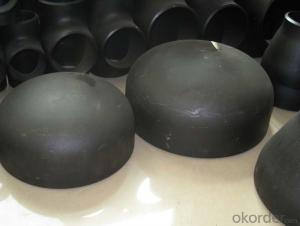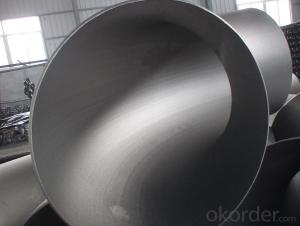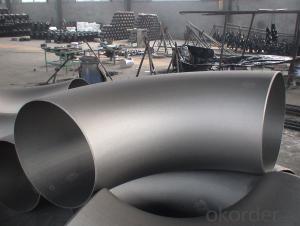Carbon Steel Pipe Fittings BEND 90DEG
- Loading Port:
- China Main Port
- Payment Terms:
- TT OR LC
- Min Order Qty:
- -
- Supply Capability:
- -
OKorder Service Pledge
OKorder Financial Service
You Might Also Like
Specifications
pipe fitting elbow
Certificate:ISO:9001-2000
New material,completely meet asme and din standard
Best price
1. type: AISI ASTM A234 WPB BW Con Elbow
2. Size: 1/2"-48"(1/2"-24"is seamless and 26"-48"is welded)
3. Wall thickness: sch10-160, STD, XS, XXS
4. Material: A234WPB, A420WPL6, A420WP5, WP11, WP12, WP22, etc
5. Welding line: seamless
6. Angle of bend: 30, 45, 90, 180degree
7. Bending radius: SR, LR
8. Standard: ANSI B16.9, JIS, SB, DIN, GB
9. Surface treatment: black paint, vanis paint, black rust-proof oil,
transparent oil, hot galvanizing
10. Application: petroleum, electricity, chemical, natural gas, metallurgy,construction,
shipbuilding and other fields because of its high pressure, high temperature, etc
11. connection: welding
12. technics:forged
13.Certificate:ISO9001 - 2000, CE, SGS, etc.
14. packaging: wooden case, pallet, container or in accordance with the
requirement of customers
15. Principle: quality fist, customer first, credit first
16. payment: L/C T/T
17. delivery time: 7-25 days after payments
18. Notes: the bevel can be made in accordance with the special requirements
of the customers
19. Others: we can also produce the products according to the requirements
of the customers
The main production:
1. PIPE FITTINGS: elbows, tees, bends, reducers, cap, flanges and sockets etc.
2. PIPE: bult welded pipes, seamless pipes, threaded pipes, etc.
We sincerely welcom customers at home and abroad to visit us and seek common development.
- Q: What are the applications of steel angles?
- Steel angles have a wide range of applications in various industries. They are commonly used in the construction industry for structural support, such as in building frames, bridges, and sign structures. Steel angles are also utilized in the manufacturing sector for machinery frames, equipment supports, and conveyor systems. Additionally, they find application in the automotive industry for chassis components, as well as in the furniture industry for manufacturing shelves and brackets. Overall, steel angles are versatile and essential components in many structural and manufacturing applications.
- Q: How is steel used in the production of medical equipment?
- Steel is commonly used in the production of medical equipment due to its strength, durability, and resistance to corrosion. It is used to manufacture various surgical instruments, such as scalpels, forceps, and scissors, as well as medical implants like joint replacements and orthopedic devices. Additionally, steel is utilized in the construction of medical equipment cabinets, tables, and frames, providing stability and reliability in healthcare settings.
- Q: How is steel used in the construction of stadiums and arenas?
- Steel is commonly used in the construction of stadiums and arenas due to its strength and durability. It is used to create the framework and support structures, such as beams, columns, and trusses, that can withstand heavy loads and provide stability. Steel is also used in the construction of roofs, façades, and seating structures, as it allows for large open spaces, flexibility in design, and efficient construction. Overall, steel plays a critical role in ensuring the safety, strength, and longevity of stadiums and arenas.
- Q: What are the different types of steel products used in the manufacturing of musical instruments?
- There are several types of steel products used in the manufacturing of musical instruments, including stainless steel, carbon steel, and nickel-plated steel. Stainless steel is commonly used for instrument bodies and parts due to its corrosion resistance and durability. Carbon steel is often used for instrument springs, as it provides strength and flexibility. Nickel-plated steel is commonly used for guitar strings, as it enhances tone and increases longevity.
- Q: How do steel products contribute to the automotive aftermarket industry?
- Steel products contribute significantly to the automotive aftermarket industry by being fundamental components in the production and repair of vehicles. From body panels and frames to engine parts and suspension components, steel is widely used due to its strength, durability, and affordability. Steel products also play a crucial role in ensuring safety by providing structural integrity to vehicles. Overall, steel's contribution to the automotive aftermarket industry is vital in maintaining and enhancing the quality, performance, and reliability of vehicles.
- Q: What are the different types of steel fasteners and their uses in the marine industry?
- In the marine industry, there are several types of steel fasteners commonly used. These include stainless steel fasteners, galvanized steel fasteners, and titanium fasteners. Stainless steel fasteners are highly resistant to corrosion and are suitable for use in environments with high levels of moisture and saltwater exposure. They are often used in marine applications such as boat building, dock construction, and offshore structures. Galvanized steel fasteners are coated with a layer of zinc to provide corrosion resistance. They are commonly used in marine applications where stainless steel might be too expensive or unnecessary, such as in non-submerged parts of boats or in marine infrastructure projects. Titanium fasteners are lightweight, yet incredibly strong and corrosion-resistant. They are commonly used in high-performance marine applications, such as racing yachts or other vessels that require components with exceptional strength-to-weight ratios. Overall, the selection of steel fasteners in the marine industry depends on the specific requirements of the project, the level of exposure to saltwater and moisture, as well as factors such as cost and performance.
- Q: What are the main properties of steel?
- The main properties of steel include high tensile strength, excellent durability, good heat resistance, and the ability to be easily shaped and welded. It is known for its hardness and toughness, making it suitable for a wide range of applications in construction, manufacturing, and automotive industries. Steel also exhibits good electrical and thermal conductivity, along with corrosion resistance, making it a popular choice for various structural and engineering purposes.
- Q: What are the different types of steel scaffolding systems?
- There are several types of steel scaffolding systems, including tube and coupler scaffolding, system scaffolding, and frame scaffolding. Tube and coupler scaffolding consists of tubes and couplers that are connected together to form a stable structure. System scaffolding uses pre-designed components that can be easily assembled and dismantled, providing flexibility and efficiency. Frame scaffolding is made up of frames and cross braces, offering a simple and sturdy solution for construction projects.
- Q: What are the applications of steel in the petrochemical industry?
- Steel has numerous applications in the petrochemical industry due to its exceptional strength, durability, and resistance to extreme temperatures and corrosive environments. It is extensively used in the construction of storage tanks, pipelines, and equipment for the processing and transportation of petrochemicals. Additionally, steel is utilized in the fabrication of heat exchangers, reactors, and furnaces, where it plays a crucial role in maintaining operational efficiency and safety.
- Q: What are the advantages of using steel for construction purposes?
- There are several advantages of using steel for construction purposes. Firstly, steel is incredibly strong and durable, making it capable of withstanding heavy loads and extreme weather conditions. Additionally, steel is a flexible material that can be easily molded into various shapes and sizes, allowing for versatile and creative designs. Moreover, steel is resistant to fire, corrosion, and pests, ensuring the longevity and safety of the structure. Furthermore, steel construction is faster and more efficient compared to traditional methods, reducing construction time and costs. Lastly, steel is a sustainable option as it is recyclable, minimizing environmental impact.
Send your message to us
Carbon Steel Pipe Fittings BEND 90DEG
- Loading Port:
- China Main Port
- Payment Terms:
- TT OR LC
- Min Order Qty:
- -
- Supply Capability:
- -
OKorder Service Pledge
OKorder Financial Service
Similar products
Hot products
Hot Searches
Related keywords





























